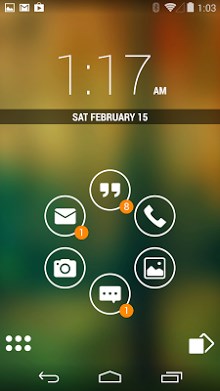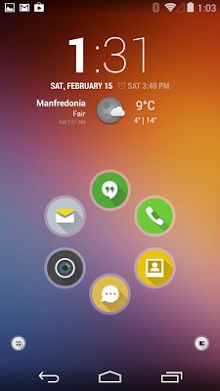

SIMPLE, LIGHT, FAST.
Smart Launcher 2 is an innovative launcher, featuring minimalist design, low resource requirements and a user-friendly interface that allows you to launch any application with just a few taps.
SL2 has been downloaded by over eight million people!
Smart Launcher 2 is an innovative launcher, featuring minimalist design, low resource requirements and a user-friendly interface that allows you to launch any application with just a few taps.
SL2 has been downloaded by over eight million people!
MINIMALIST DOES NOT MEAN UNDER FEATURED
Smart Launcher 2 is completely different from any other launcher on Play Store. It has been written from scratch.
Smart Launcher 2 is completely different from any other launcher on Play Store. It has been written from scratch.
The Flower
It gives you access to the most common apps. No need to select every time a specific app for the activity you want to start. The double tap option allows you to launch a second activity from the same icon.
It gives you access to the most common apps. No need to select every time a specific app for the activity you want to start. The double tap option allows you to launch a second activity from the same icon.
The Drawer
It automatically organizes your apps into a few important categories. Exploring and finding your apps has never been so easy.
It automatically organizes your apps into a few important categories. Exploring and finding your apps has never been so easy.
Themes and lockscreens
Almost every element of the UI is customizable. SL2 supports every Apex and Nova icon set, and more than 300 themes have been created specifically for Smart Launcher!
Almost every element of the UI is customizable. SL2 supports every Apex and Nova icon set, and more than 300 themes have been created specifically for Smart Launcher!
Plugins, Notifications and Customizable gestures
Add features by installing what you need. Get notifications directly on your homescreen
and assign gestures to your favorite apps to allow you to start them faster.
Add features by installing what you need. Get notifications directly on your homescreen
and assign gestures to your favorite apps to allow you to start them faster.
Hide unused apps
You can hide whatever apps you want, and if you want to protect your apps against prying eyes you can protect them with a password.
You can hide whatever apps you want, and if you want to protect your apps against prying eyes you can protect them with a password.
One launcher to rule them all
SL2 is optimized for almost every Android device. You can use it on your phone, on your tablet and even on your Google TV. Every part of SL is designed to be comfortably used both in portrait and landscape mode.
SL2 is optimized for almost every Android device. You can use it on your phone, on your tablet and even on your Google TV. Every part of SL is designed to be comfortably used both in portrait and landscape mode.
Constantly updated
Since June 2012 SL2 has been updated more than 150 times. It completely supports the latest Android API, and we always listen to user suggestions. Do you want to help us with the testing of new versions? Join the beta g+ community : plus.google.com/u/0/communities/114803489211052363907
Since June 2012 SL2 has been updated more than 150 times. It completely supports the latest Android API, and we always listen to user suggestions. Do you want to help us with the testing of new versions? Join the beta g+ community : plus.google.com/u/0/communities/114803489211052363907
Size : 1.8M
Current Version : 2.5
Requires Android : 2.1 and up
Current Version : 2.5
Requires Android : 2.1 and up




















